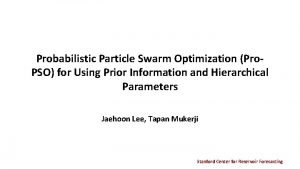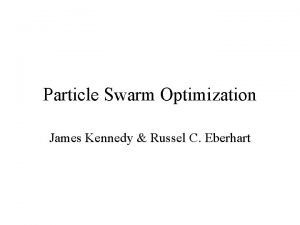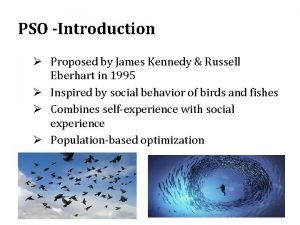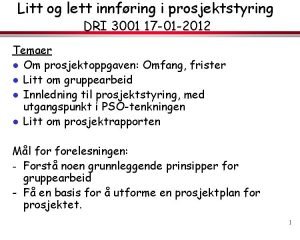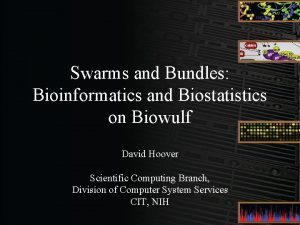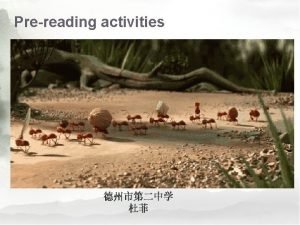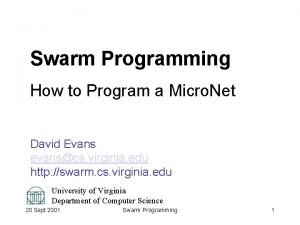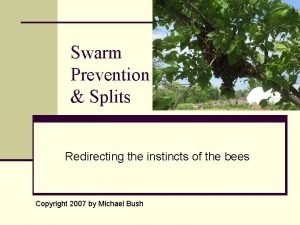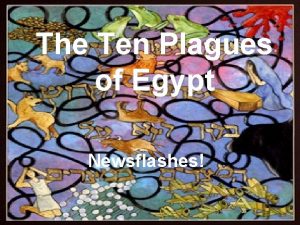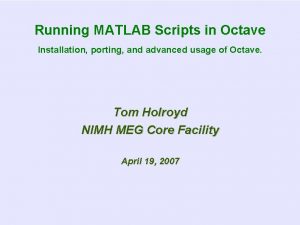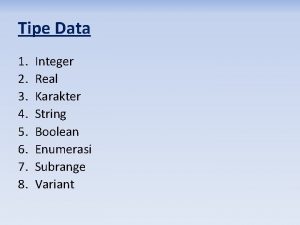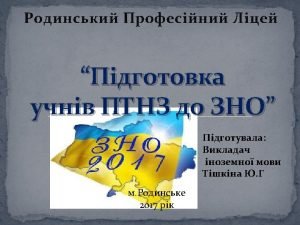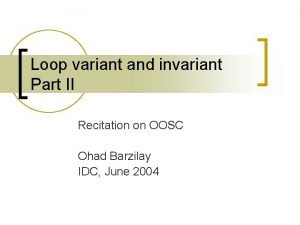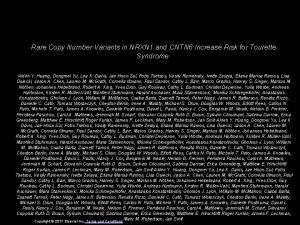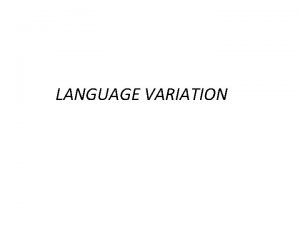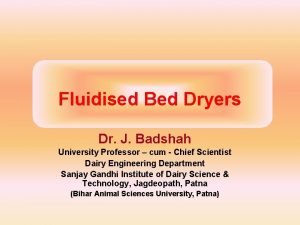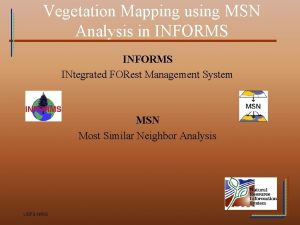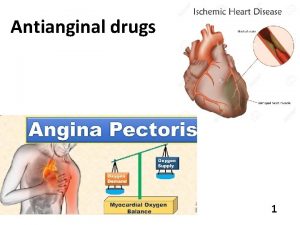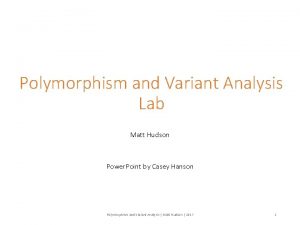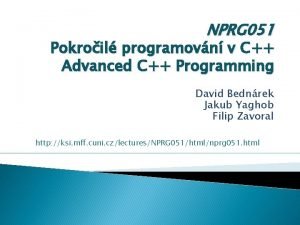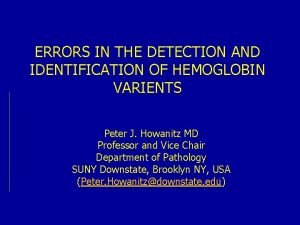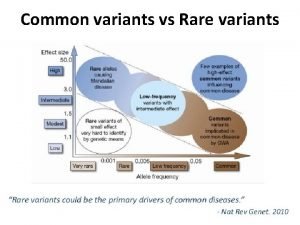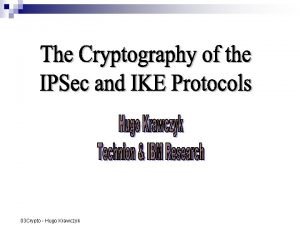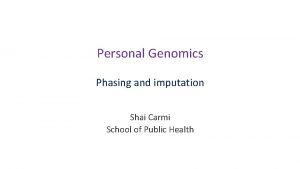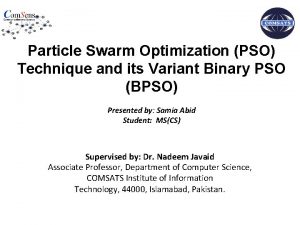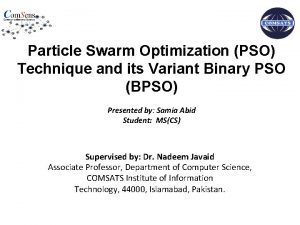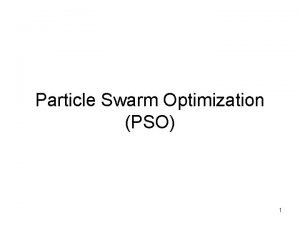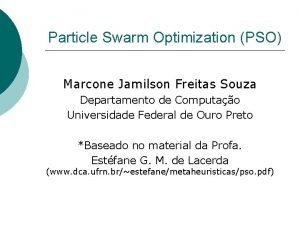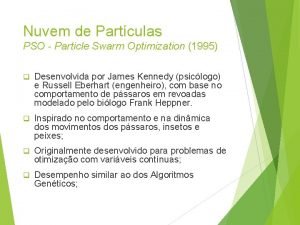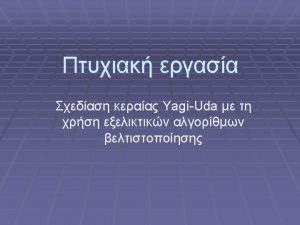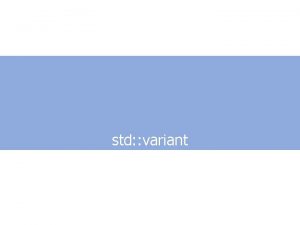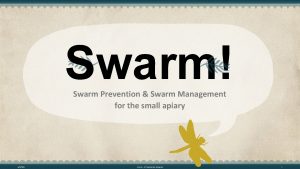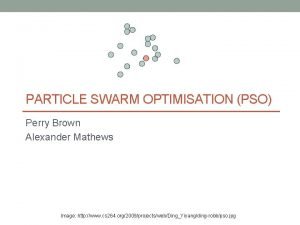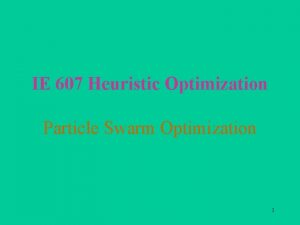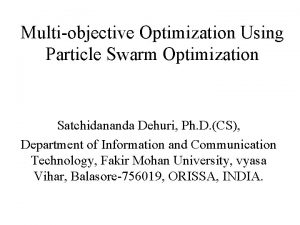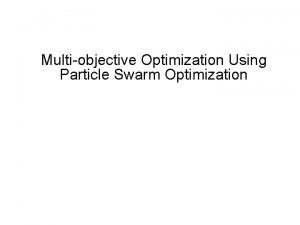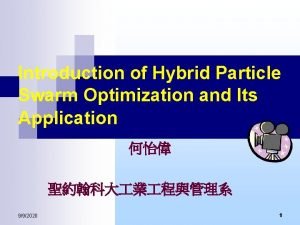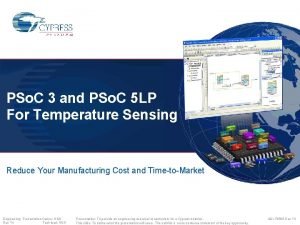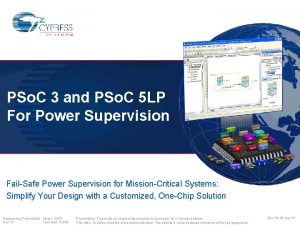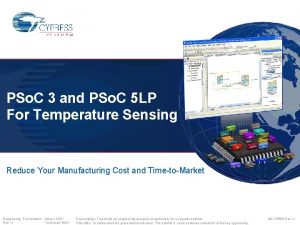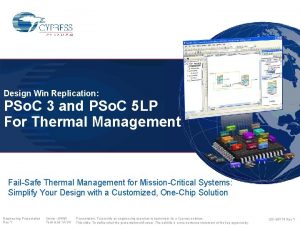Particle Swarm Optimization PSO Technique and its Variant







![6 PSO (1/2) § First described in 1995 [2]. § By James Kennedy and 6 PSO (1/2) § First described in 1995 [2]. § By James Kennedy and](https://slidetodoc.com/presentation_image/267faf267c35c2121af166657e8db97b/image-8.jpg)



![How does it Work? (1/2) § Initialized with a group of random particles [4]. How does it Work? (1/2) § Initialized with a group of random particles [4].](https://slidetodoc.com/presentation_image/267faf267c35c2121af166657e8db97b/image-12.jpg)










![PSO Characteristics § Pros [5] – Simplementation – Suitable for concurrent processing – Derivative PSO Characteristics § Pros [5] – Simplementation – Suitable for concurrent processing – Derivative](https://slidetodoc.com/presentation_image/267faf267c35c2121af166657e8db97b/image-23.jpg)







![Energy Optimization by BPSO (1/10) [6] No of Homes 1 No of Appliances 13 Energy Optimization by BPSO (1/10) [6] No of Homes 1 No of Appliances 13](https://slidetodoc.com/presentation_image/267faf267c35c2121af166657e8db97b/image-31.jpg)










- Slides: 41

Particle Swarm Optimization (PSO) Technique and its Variant Binary PSO (BPSO) Presented by: Samia Abid Student: MS(CS) Supervised by: Dr. Nadeem Javaid Associate Professor, Department of Computer Science, COMSATS Institute of Information Technology, 44000, Islamabad, Pakistan.

Outline Bio-inspired algorithms Why bio-inspired techniques. Taxonomy of bio-inspired techniques. What is swarm intelligence? § § – § § Applications What is Particle Swarm Optimization (PSO)? – How does it work? – PSO algorithm. – Algorithm example. – Characteristics. BPSO – How does it work? – Energy optimization by BPSO. 2

Bio-inspired algorithms § Bio-inspired algorithms are search methods that simulate the natural biological evolution or the behaviour of biological entities [1]. § Bio inspired algorithms has a wide range of applications covering all most all areas including: – – – – – Computer networks Security Robotics Bio medical engineering Control systems Parallel processing Data mining Power systems Production engineering and many more. [1] Binitha, S. , and S. Siva Sathya. "A survey of bio inspired optimization algorithms. " International Journal of Soft Computing and Engineering 2, no. 2 (2012): 137 -151. 3

Why Bio-inspired techniques? § Optimization is a commonly encountered mathematical problem in all engineering disciplines. It literally means finding the best possible/desirable solution [1]. § Optimization problems are wide ranging and numerous. § Optimization algorithms: – Deterministic – Stochastic in nature § Former methods to solve optimization problems require enormous computational efforts, which tend to fail as the problem size increases. § This is the motivation for employing bio inspired stochastic optimization algorithms as computationally efficient alternatives to deterministic approach. 4

Bio-inspired techniques Evolutionary Swarm Intelligence Ecological GA GP ES DE PFA PSO ACO ABC BFA BBO AWC PS 2 O GSO FA SFLA FSA Taxonomy of Bio-inspired techniques 5

Swarm Intelligence (SI) § Algorithms inspired by the collective behavior of social insect colonies and other animal societies are called swarm intelligence algorithms. § The expression was introduced by Gerardo Beni and Jing Wang in 1989, in the context of cellular robotic systems [2]. § SI systems are typically made up of a population of simple agents interacting locally with one another and with their environment. § Natural examples: Ant colonies Bacteria growth Bird flocking Animal herding Fish schooling. [2] Yang, Xin-She, Zhihua Cui, Renbin Xiao, Amir Hossein Gandomi, and Mehmet Karamanoglu, eds. Swarm intelligence and bio-inspired computation: theory and applications. Newnes, 2013. 6

SI Applications § U. S. Military is investigating swarm techniques for controlling unmanned vehicles. § Home energy management in Smart grid. § NASA is investigating the use of swarm technology for planetary mapping. 7
![6 PSO 12 First described in 1995 2 By James Kennedy and 6 PSO (1/2) § First described in 1995 [2]. § By James Kennedy and](https://slidetodoc.com/presentation_image/267faf267c35c2121af166657e8db97b/image-8.jpg)
6 PSO (1/2) § First described in 1995 [2]. § By James Kennedy and Russel C. Eberhert. § Inspired by social behavior of birds and fishes. 8

7 PSO (2/2) § Combines self-experience with social experience. § Population-based optimization. § Find approximate solutions of problems. § Easy to implement. § Few parameters to adjust. [3] Pinto. “The Particle Swarm Optimization algorithm. interne: http: //pa ginas. fe. up. pt/~mac/ensino/docs/DS 20102011/Presentations/ Populational. Metaheuristics/PSO__Andry. Pinto_Ines. Domingues_Luis. Rocha _Hugo. Alves_Susana. Cruz. pptx, Jun. 27, 2013 [Jan. 31, 2017]. 9

Concept (1/2) § Similarly to genetic algorithm (GA), it is a population-based method. § It represents the state of the algorithm by a population, which is iteratively modified until a termination criterion is satisfied. § Uses a number of particles that make a swarm moving around in the search space looking for the best solution § Each particle in search space adjusts its “flying” according to: § its own flying experience § the flying experience of other particles. 10

Concept (2/2) § In PSO, each single solution is a "bird" in the search space. We call it "particle". § All the particles have fitness values which are evaluated by the fitness function. § All particles have velocities, which direct the flying of the particles. § The particles fly through the problem space by following the current optimum particles. 11
![How does it Work 12 Initialized with a group of random particles 4 How does it Work? (1/2) § Initialized with a group of random particles [4].](https://slidetodoc.com/presentation_image/267faf267c35c2121af166657e8db97b/image-12.jpg)
How does it Work? (1/2) § Initialized with a group of random particles [4]. § Searches for optimal by updating generations. § Particles move through the solution space, and are evaluated according to some fitness criterion. § In every iteration, each particle is updated by following “best” values. – Pbest – Gbest [4] Clerc, Maurice. Particle swarm optimization. Vol. 93. John Wiley & Sons, 2010. 12

How does it Work? (2/2) Each particle tries to modify its current position and velocity according to the distance between its current position and Pbest, and the distance between its current position and gbest [3]. – Update particles’ velocities: – Move particles to their new positions: Vn+1 Particle velocity at n+1 th iteration C 1 Acceleration factor related to gbest C 2 Acceleration factor related to lbest Rand 1 Random number between 0 and 1 gbest position of swarm Pbest position of swarm Pn Current position of particle 13

PSO-Algorithm • For each particle – Initialize particle with random number End DO – For each particle • Calculate the fitness value • If fitness values at time t is better than the its previous best fitness value (Pbest) at time (t-1) • Set current value as the new Pbest END – Choose the particle with the best fitness value of all the particles as the gbest For each particle • Update velocity • Update position – While maximum iterations not reached. – 14

Algorithm-Example (1/8) 15

Algorithm-Example (2/8) 16

Algorithm-Example (3/8) 17

Algorithm-Example (4/8) 18

Algorithm-Example (5/8) 19

Algorithm-Example (6/8) 20

Algorithm-Example (7/8) 21

Algorithm-Example (8/8) 22
![PSO Characteristics Pros 5 Simplementation Suitable for concurrent processing Derivative PSO Characteristics § Pros [5] – Simplementation – Suitable for concurrent processing – Derivative](https://slidetodoc.com/presentation_image/267faf267c35c2121af166657e8db97b/image-23.jpg)
PSO Characteristics § Pros [5] – Simplementation – Suitable for concurrent processing – Derivative free – Very few algorithm parameters – Very efficient global search algorithm § Cons [5] – Premature convergence in mid optimum points – Slow convergence in refined search stage (weak local search ability) [5] Kumar, Ashok, Brajesh Kumar Singh, and B. D. K. Patro. "Particle Swarm Optimization: A Study of Variants and Their Applications. " International Journal of Computer Applications 135, no. 5 (2016): 24 -30. 23

BPSO is a conventional algorithm Applicable for continuous problems. However, it cannot be applied to discrete problems directly. Aiming at the discrete problems, Kennedy and Eberhart extended the PSO to BPSO in 1997 [5] § It is a binary variant of PSO. § § 24

How does it work? (1/2) § In BPSO, population has a set of particles. § Each individual particle represents a binary decision. § This decision can be represented by either YES/TRUE=1 or NO/FALSE=0. § All particles represent their positions through binary values which are 0 or 1. § Velocity is restricted within the range {0, 1} 25

How does it work? (2/2) § The velocity vector equation and position vector equation are defined as [5]: – velocity vector equation: – position vector equation: – r is the random number selected from a uniform distribution in [0, 1]. 26

BPSO-Example 1 (1/4) § As an example, let’s say that we are dealing with a population of 5 bit binary particles and a population of 4 particles. Particle 2 1 0 1 0 1 1 1 0 0 0 1 1 0 1 § We are updating particle 2 (01011), bit 3(0) 27

BPSO-Example 1 (2/4) § Furthermore, we will assume that the current velocity of this bit to be a 1 is 0. 25. § Furthermore, assume that the best value of this particle (to date) is 00100. § And the best value of the whole population (to date) is 01111. 28

BPSO-Example 1 (3/4) 29

BPSO-Example 1 (4/4) § Now, with the value for f, we generate a random number. § If the random number is less than f then bit x becomes a 1 otherwise, it becomes a 0. 30
![Energy Optimization by BPSO 110 6 No of Homes 1 No of Appliances 13 Energy Optimization by BPSO (1/10) [6] No of Homes 1 No of Appliances 13](https://slidetodoc.com/presentation_image/267faf267c35c2121af166657e8db97b/image-31.jpg)
Energy Optimization by BPSO (1/10) [6] No of Homes 1 No of Appliances 13 Timeslots 24 hours. Appliances Power Rating (k. W/h) Lights 0. 6 Coffee Maker (CM) 0. 8 Fans 0. 75 Washing Machine (CM) 0. 78 Clothes Iron 1. 5 Dish Washer (DW) 3. 60 Microwave Oven 1. 18 Cloth Dryer (CD) 4. 40 Toaster 0. 5 Air Conditioner (AC) 1. 44 Refrigerator 0. 73 Water Heater (WH) 4. 45 Space Heater (SH) 1. 50 [6]. Rahim, Sahar, Nadeem Javaid, Ashfaq Ahmad, Shahid Ahmed Khan, Zahoor Ali Khan, Nabil Alrajeh, and Umar Qasim. "Exploiting heuristic algorithms to efficiently utilize energy management controllers with renewable energy sources. " Energy and Buildings 129 (2016): 452 -470. 31

Energy Optimization by BPSO (2/10) Appliances Fixed Shiftable Elastic LOT cannot be modified (Not Shiftable) Can be shifted without altering load profile. Can be shifted to a suitable time Lighting Fan, Iron, Microwave over, Toaster, Cofee maker (Uninterruptible) Washing machine, Dish washer, Clothes dryer (Interruptible) Air conditioner, water heater, space heater 32

Energy Optimization by BPSO (3/10) Parameters of shiftable appliances Appliances Start time End time Waiting time Washing machine 8 16 5 Dish washer 7 12 5 Clothes dryer 6 18 5 Parameters of elastic appliances Appliances Start time End time Air conditioner 6 24 Water heater 6 24 Space heater 6 24 33

Energy Optimization by BPSO (4/10) BPSO Parameters Swarm size 200 Vmax (maximum velocity) 4 m/s Vmin (minimum velocity) -4 m/s Max iterations 600 C 1 2 C 2 2 34

Energy Optimization by BPSO (5/10) Key terms corresponding to Smart grid optimization PSO Parameters Role in HEM General use Particle A timeslot (One possible solution) Possible solution in search area swarm Set of possible solutions a set of particles Dimension Number of appliances Search area Fitness function Designed objective function with Objective function constraints Position Initialize vector for appliances states randomly. Initialization point in search area Velocity Probability of the bit to be 1. (To turn on the appliance. ) Randomly generated Particle best (Pbest) Local best values for state array that satisfy objective function. Evaluated fitness function answer Global best (Gbest) Globally best solution that satisfy Evaluated fitness function all constraints (A timeslot) answer 35

Energy Optimization by BPSO (6/10) • Step 1: – Initialize Particles with random number (randomly generate population) – Set initial position of particles as Pbest. Code to randomly generate population for j=1: swarm for i=1: n if rand(1)>0. 5 X=1; else X=0; end x 1(j, i)=X; end WM DW CD AC WH SP 0 1 1 1 0 0 0 0 1 : : : 0 0 1 36

Energy Optimization by BPSO (7/10) • Step 2: – For Each Particle • Calculate the fitness Function: 1. 1. 2. 3. 4. 5. function [FF]=obj(electricity_cost, power rating, x 1, swarm, d) for i=1: swarm FF(i, 1)=electricity_cost*x 1(i, : )'; err=c_electricity_cost*x 1(i, : )'-d; FF(i, 1)=FF(i, 1)+1000*abs(err); end WM DW CD AC WH SP Fitness 0 0 1 1 0 1 2. 4894 0 1 1 0 2. 4916 0 1 1 1 0 0 2. 4956 0 2. 4888 : : : 0 1 1 37

Energy Optimization by BPSO (8/10) • Step 3: – Choose the Timeslot (solution) with the best fitness value among all possible solutions as the gbest. 0 Gbest solution 1 0 1 1 0 WM DW CD AC WH SP Fitness 0 0 1 1 0 1 2. 4894 0 1 1 0 2. 4916 0 1 1 1 0 0 2. 4956 0 2. 4888 : : : 0 1 1 38

Energy Optimization by BPSO (9/10) • Step 4: – For each Particle • Update its velocity. • Update its position. • Step 5: – While maximum iterations not reached. v Note: Repeat this process 24 times to get the most optimal solution for each timeslot. 39

Energy Optimization by BPSO (10/10) MATLAB CODE: 1. 2. 3. 4. 5. 6. 7. 8. 9. 10. 11. 12. 13. 14. 15. 16. 17. 18. 19. for i = 1: swarm for j = 1: n v(i, j) = v(i, j)+c 1*rand(1)*(pbest(i, j)-x_BP(i, j))+c 2*rand(1)*(gbestt_BP(1, j)-x_BP(i, j)); if ( (v(i, j) <= vmax) && (v(i, j)>=vmin) ) v(i, j) = v(i, j); elseif ( v(i, j) < vmin ) v(i, j) = vmin; elseif ( v(i, j) > vmax ) v(i, j) = vmax; end This shows the velocity of the sig(i, j) = 1/(1+exp(-v(i, j))); particle should stay in a limit if rand(1) < sig(i, j) x_BP(i, j) = 1; Apply sigmoidal function on else the velocity x_BP(i, j) = 0; end 40

Any questions? 41
 Assembly scheme in system software
Assembly scheme in system software Pso pro
Pso pro James kennedy pso
James kennedy pso Self-funded pso
Self-funded pso Kennedy and eberhart
Kennedy and eberhart Pso prosjekt
Pso prosjekt Fases do estresse
Fases do estresse Biowulf swarm
Biowulf swarm Swarm theory reading answers
Swarm theory reading answers Swarm programming
Swarm programming Swarm prevention split
Swarm prevention split Newsflash swarm
Newsflash swarm Run matlab script in octave
Run matlab script in octave Comboware
Comboware #**# merupakan karakter yang terdapat pada type data
#**# merupakan karakter yang terdapat pada type data Mark the correct variant to complete the sentence
Mark the correct variant to complete the sentence Contoh varian dan invarian dalam algoritma
Contoh varian dan invarian dalam algoritma What is loop variant
What is loop variant Atherosclerosis plaque development
Atherosclerosis plaque development Cough varient asthma
Cough varient asthma Nrxn copy number variant
Nrxn copy number variant Regional variation in language
Regional variation in language Plug flow dryer is variant of
Plug flow dryer is variant of Define capp
Define capp Architecture of 8086 microprocessor with block diagram
Architecture of 8086 microprocessor with block diagram Fvs variant map
Fvs variant map Variant angina
Variant angina Variant analysis
Variant analysis Lambda variant
Lambda variant Variant math
Variant math Hemoglobin variant
Hemoglobin variant Rare variant
Rare variant Hugo krawczyk
Hugo krawczyk Snp variant
Snp variant Snp variant
Snp variant Snp variant
Snp variant Direct speech simple present
Direct speech simple present They accuse me of being dark in their free city
They accuse me of being dark in their free city Its halloween its halloween the moon is full and bright
Its halloween its halloween the moon is full and bright When a train increases its velocity its momentum
When a train increases its velocity its momentum Its cloudy its sunny
Its cloudy its sunny If its square its a sonnet summary
If its square its a sonnet summary

